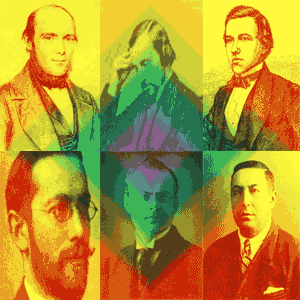Relive the Romantic Era of Chess

Anderssen, Zukertort and Morphy were major players in the Romantic Era
Anderssen followed by Morphy followed by Zukertort were some of the leading players in the Romantic Generation. They played the one step ahead approach. In many of their games they would finish by mating with a breath taking five or six move combo. Their opponent would often be just one agonizing move from victory, yet denied the possibility to ever play it.
There were structural weaknesses to their approaches that were there to be capitalized on but this would not happen until much later when the Modern Era of positional chess was ushered in. Whatever about the foundations they were built on, the innovation and invention of these combinations at least have stood the test of time. They are as inspiring today as they were in the days that they were played. Add your own annotated Romantic Era game.
Chess Evolution
17.Rd8# does it, A Night at the Opera is regarded by many as one of the most famous games ever played
The rule changes that evolved their Shatranj into Western chess came about soon after. Chess was seen as one of the arts by the royal courts and chess players studied their art. Secrets were unfurled one by one as the greatest players unearthed the secrets of the game.
Greco demonstrated the power of active pieces and later Philidor brought to light the pawn's role in the game. Armed with this knowledge, chess players took their discipline along with all the other arts into an enlightened period in the 19th Century.
Now the main emphasis was on the potential for beauty. Just as the great composers had done for music and theater, the great chess players were bringing chess into the Romantic Era of the 19th Century.
The Grace of the Matador
Black resigns after 24.Rad1. Paul Morphy (White) builds up a spectacular lead in development against Jules Arnous de Riviere (Black) by relentlessly chasing the Black Queen around the board
The greatest players of this time calculated variations as well as anyone in modern chess. Their games may contain openings that wouldn't pass muster today, but the tactical play in the middlegame, the beautifully executed mating attacks are as impressive today as they were when they were played.
What are the characteristics of a beautiful game of chess? It has to have remarkable combinations complete with sacrifice. But not any old sacrifice. It has to be the kind of sacrifice that the mere mortal would never find. Something that requires a spark of genius. That's what makes us marvel.
The Art of the Sacrifice
P Morphy vs A Morphy, 1850 - 13 year old Paul Morphy frog marches his father Alonso's King to the 8th rank in a fine King Hunt before delivering checkmate with 18.0-0#
Spielmann was a very strong player, appearing in many of the strongest tournaments between 1910 and 1930. He was one of the most famous of the Romanticists, at a time when that brand of chess had largely died out.
Spielmann's games show what is possible in chess and his words explain the landscape required for these combinations to arise.
The Love of the Gambit
Evans Gambit - 1.e4 e5 2.Nf3 Nc6 3.Bc4 Bc5 4.b4, a firm favorite during the Romantic Era
The openings of the Romantic Era were designed to create open lines and diagonals, development leads and initiatives against the opposing King.
Many of these openings contained sacrifices within them. These opening sacrifices are known as gambits. Spielmann was particularly fond of the King's Gambit and the Center Game.
The Heavyweights of Romanticism
Matschego - Falkbeer, 1853 - This magical game concludes with another remarkable King Hunt, it's done and dusted after 25...Ne8#
Johannes Zukertort was a Prussian master. He contested the first World Chess Championship in 1886 which marked a watershed in the history of chess. Zukertort, the hero of romanticism was vanquished by Steinitz, the pioneer of modernism (positional chess) and with his defeat the Romantic Era was brought to an end.
Paul Morphy was the ultimate chess enigma. The greatest chess mind the world had ever witnessed to that point and arguably since, Morphy swept aside all opponents that sat across the board from him including Anderssen. He had, through unswerving determination, emphatically conquered the chess world by the age of 21. He then had promptly walked away by 22, equally determined never to compete again. It should be noted that Morphy vanquished his opponents because he had a full grasp of positional realities and enveloped his tactics within a positional game.
The Brilliancies
Anderssen checkmates Dufrense in the famous Evergreen Game in Berlin in 1852 with 24.Bxe7#
Steinitz was as fine a Romanticist as anyone else with remarkable victories playing in this style before converting to his positional style. Blackburne and Kieseritzky also played some memorable games.
Literally hundreds of games could have been chosen as examples of the Romantic Era at it's most exhilarating but I cut the roll of honor at 10. Enjoy these breath taking brilliancies.
What's Your Favorite Game From the Romantic Era?
The Romantic Era was the Golden Age for artistic combinations in chess. The popular style of play in those days was all out attack with stylish interplay between the pieces. It left behind it a legacy of beautiful games and we all have our favorites. What chess game from this era most captured your imagination? Enter it here with your annotations explaining the moves. Talk us through the sheer genius behind the combinations. What's your favorite game from the Romantic Era?
Romantic Era Games Left by other Contributors
Click below to see Romantic Era Games by other Contributors...
Rosanes - Anderssen 1862 Not rated yet
The 19th Century was a time of open attacking chess. The following game demonstrates the dominating mood in the chess world in the pre-Steinitz era.
…
Duels Between Masters Not rated yet
Every king, civilization, and country has its own era in which it was influential, progressive and revered. This same theory applies to sports and games …
Moving On

These guys played some of the most famous chess games ever
We like to think that the Romantic Era never completely died. We appreciate those fantastic tactical combos when they still pop up amid all of the sensible positional science.
Now that you've experienced some of the finest games from the Romantic Era and your appetite for masterful chess has been whipped up, I want to share with you some of the most famous chess games of all times.






